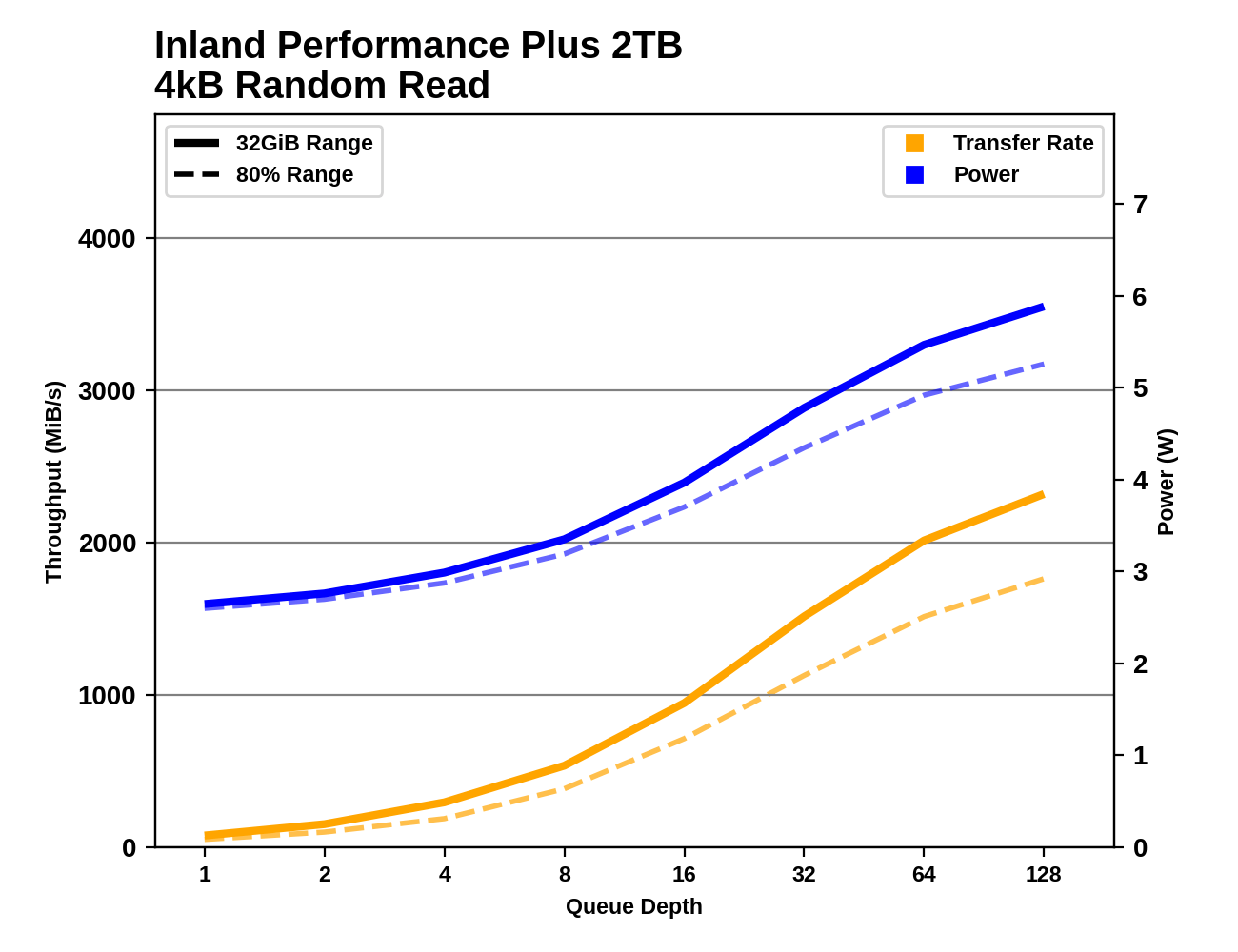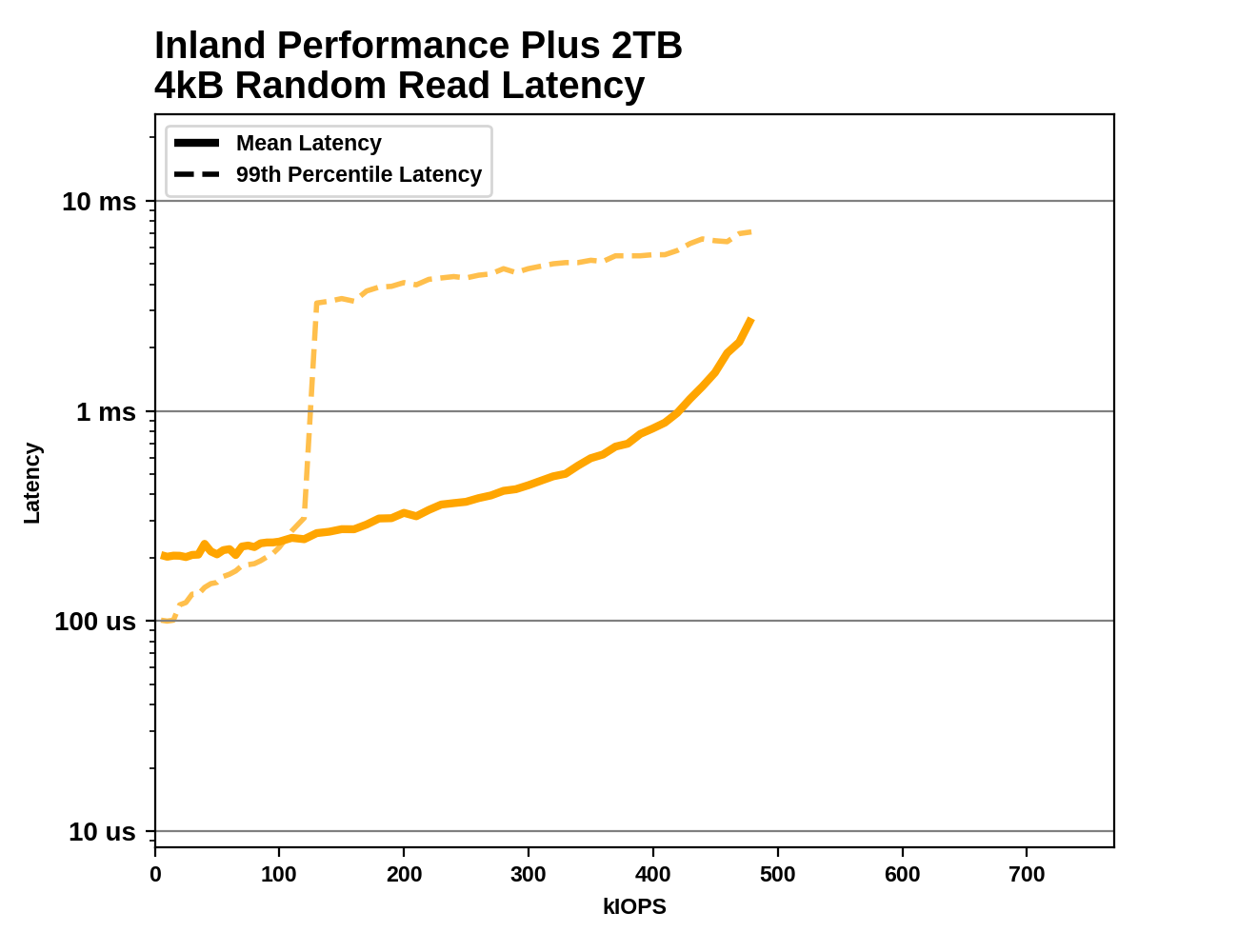The Inland Performance Plus 2TB SSD Review: Phison's E18 NVMe Controller Tested
by Billy Tallis on May 13, 2021 8:00 AM ESTBurst IO Performance
Our burst IO tests operate at queue depth 1 and perform several short data transfers interspersed with idle time. The random read and write tests consist of 32 bursts of up to 64MB each. The sequential read and write tests use eight bursts of up to 128MB each. For more details, please see the overview of our 2021 Consumer SSD Benchmark Suite.
 |
|||||||||
| Random Read | Random Write | ||||||||
| Sequential Read | Sequential Write | ||||||||
On the QD1 burst IO tests, the Inland Performance Plus tops the charts for both random and sequential writes, though in the latter case performance drops quite a lot when the drive is mostly full. Random read performance is merely average, and sequential reads are disappointingly in last place.
Sustained IO Performance
Our sustained IO tests exercise a range of queue depths and transfer more data than the burst IO tests, but still have limits to keep the duration somewhat realistic. The primary scores we report are focused on the low queue depths that make up the bulk of consumer storage workloads. For more details, please see the overview of our 2021 Consumer SSD Benchmark Suite.
 |
|||||||||
| Random Read | Throughput | Power | Efficiency | ||||||
| Random Write | Throughput | Power | Efficiency | ||||||
| Sequential Read | Throughput | Power | Efficiency | ||||||
| Sequential Write | Throughput | Power | Efficiency | ||||||
On the longer IO tests that bring in some higher queue depths, the Performance Plus loses its first-place spot for random writes to the WD Black SN850, but it hangs on to first place for sequential writes. For both random and sequential reads it manages to improve its standings slightly, but the sequential read performance remains disappointing. Power efficiency isn't great on any of these four tests, but it's decent for sequential writes and more or less matches the flagship Gen4 drives from WD and Samsung.
 |
|||||||||
| Random Read | |||||||||
| Random Write | |||||||||
| Sequential Read | |||||||||
| Sequential Write | |||||||||
The Inland Performance Plus does eventually reach top-tier performance for sequential reads, but it requires higher queue depths than the 980 PRO or SN850. For sequential writes, it has taken a clear lead by QD4 and maintains higher performance than any of the other drives can hit, with only a slight drop at the end of the test suggesting that the SLC cache might be starting to run out.
For random reads and writes, the Performance Plus simply doesn't scale up as high as its competitors, even with very large queue depths. The Samsung 980 PRO's maximum random write speeds are well beyond what any other drive hits, and for random reads the WD Black SN850 has a similarly large lead over the competition.
Random Read Latency
This test illustrates how drives with higher throughput don't always offer better IO latency and Quality of Service (QoS), and that latency often gets much worse when a drive is pushed to its limits. This test is more intense than real-world consumer workloads and the results can be a bit noisy, but large differences that show up clearly on a log scale plot are meaningful. For more details, please see the overview of our 2021 Consumer SSD Benchmark Suite.
 |
|||||||||
At low rates, the mean latency from the Inland Performance Plus is actually higher than the 99th percentile latency, indicating there's a small number of extremely high-latency IOs skewing the average. The median latency starts at a very respectable 63µs, but the highest latency measured at low rates is close to 70ms—three orders of magnitude slower. This looks like the drive might be stalling while waking up from a sleep state, which it shouldn't even be entering given the minimal idle time between test phases. Above 120k IOPS, the 99th percentile latency jumps up to the millisecond range, which should only happen to a drive this high-end when it's pretty close to its maximum throughput. The Performance Plus does achieve respectable throughput that is a clear improvement over the Phison E16, but compared to WD and Samsung flagships the E18 drive is slower and has some mildly concerning performance quirks.










118 Comments
View All Comments
DominionSeraph - Thursday, May 13, 2021 - link
Try an optimized OS like XP. There's really no difference.philehidiot - Thursday, May 13, 2021 - link
I do actually have windows 95 installed as a VM, running off an SSD. If you want to really understand how bloated and sluggish Windows 10 is, try using Windows 95 and see how far they have regressed in pursuit of looking pretty.GeoffreyA - Friday, May 14, 2021 - link
Even XP feels faster, on an older computer, than 10. Vista is where the sluggishness crept in.GeoffreyA - Friday, May 14, 2021 - link
Also, software in general has become more sluggish, owing to excessive use of abstractions, frameworks, and modern languages.jospoortvliet - Friday, May 14, 2021 - link
Software has become vastly more complex as users demand more and more features and slick interfaces. Also, platforms evolve faster and more need to be supported. Developers have less time per feature so more abstractions and higher level languages are needed. You can't write code in a browser that is as efficient as good old assembly as it has to run everywhere and even if you could you would lose to a competitor who wrote more features with less developers....So yeah, you are right but it is a trend that is hard to reverse.
GeoffreyA - Friday, May 14, 2021 - link
Quite true, but one can't help feeling a pang of regret when looking at today's applications vs. those rare C/C++ Win32 ones that, as they say, just fly.FunBunny2 - Saturday, May 15, 2021 - link
"Quite true, but one can't help feeling a pang of regret when looking at today's applications vs. those rare C/C++ Win32 ones that, as they say, just fly."true fact. I used 1-2-3 pretty much from version 1, which is X86 assembler as was DOS. somewhere around 2.4 it was re-written in C (C++ didn't yet exist). the first time I fired up 2.4 1-2-3 (on a 640K 8088) what had been instant screen updates were now slow as molasses up hill in winter; you could see individual elements change, one by one.
it appears to be the fact that the constant push and pull between node shrink, more transistors, phatter cpu, more memory on the one hand and software bloat on the other doesn't balance out. I've always been sceptical of ever-increasing number of 'tiers' in the memory hierarchy paired with load-store architectures. may haps persistent memory will give us a true Single Level Storage that's more performant than just virtual storage/memory. have to work out a new version of transaction control, though.
GeoffreyA - Saturday, May 15, 2021 - link
Well, soon they'll need some big changes, when the quantum limits set by Nature are hit. As for the software, yes, it tends to get slower as time goes by. Any gains in hardware are quickly reversed. I think there's been a view inculcated against C++, instigated by Java perhaps, that it's not safe, it's bad, and so one needs to use a better, more modern language; or if C++, do things in an excessive object-oriented way, away from the lighter C sort of style. As in all of life, even "good" programming principles can be taken too far. So moderation is best.FunBunny2 - Saturday, May 15, 2021 - link
"if C++, do things in an excessive object-oriented way, away from the lighter C sort of style."C has been described as the universal assembler. pretty much true, esp. if you limit the description to the bare language w/o the many libraries. a C program can be blazingly fast, if the code treats the machine as a Control Program would. but that's how the PC World was nearly extinguished in the late 80s and early 90s by viruses of all kinds. I'm among those who spent more time than I wanted, editing with Norton Disk Doctor. not an era I miss.
GeoffreyA - Sunday, May 16, 2021 - link
Oh, yes, programs were doing their own thing, till OS's began to clamp down. As years went by, security got more attention too, as it should, and newer languages guaranteed different types of safety. An important point in this era where so much of our information is handled electronically. Or portability made easier, or maintenance.